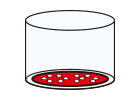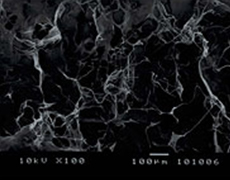Collagen Sponge for 35 mm Culture Dish
This porous cross-linked sponge shaped scaffold is prepared from insoluble type I collagen derived from bovine Achilles tendon and is suitable for culturing cells.
Features and Applications
 |
| Cell Culture |
- This porous cross-linked sponge shaped scaffold is prepared from insoluble type I collagen derived from bovine Achilles tendon and is suitable for culturing cells.
SEM image of a sponge surface
Type of Collagen
Bovine tendon derived insoluble collagen
Product
| Product name (click for order info) | Cat no (click for datasheet) | Size | |
| Collagen sponge for 35mm culture dish | KOU-CS-35 | 5 Pieces | |
Frequently Asked Questions
Is the sponge suitable for cell transplantation?
This sponge is made from native collagen and retains the telopeptides, which have antigenicity. We recommend using MIGHTY or Honeycomb sponge for customers wishing to perform cell transplantation.
Is the sponge applicable to 3D culture?
There is a thin layer of collagen at the surface of this sponge so cells remain on the sponge surface after cell seeding. Following cell culture for approximately a week, the cells begin to penetrate the inside of the sponge.
References
Immunology- Nestin+ Mesenchymal Precursors Generate Distinct Spleen Stromal Cell Subsets and Have Immunomodulatory Function.
Huang J, Deng R, Li W, Jiang M, Xiang AP, Zhang X.
Int J Mol Sci. 2022 Oct 5;23(19):11819. PMID: 36233119. - Gel-Trapped Lymphorganogenic Chemokines Trigger Artificial Tertiary Lymphoid Organs and Mount Adaptive Immune Responses In Vi vo. Kobayashi Y, Watanabe T. Front Immunol. 2016 Aug 22;7:316. PMID: 27597851
- Stromal cells as trend-setters for cells migrating into the lymph node. Buettner M, Dittrich-Breiholz O, Falk CS, Lochner M, Smoczek A, Menzel F, Bornemann M, Bode U. Mucosal Immunol. 2015 May;8(3):640-9. PMID: 25354321
- Meis1 is required for the maintenance of postnatal thymic epithelial cells. Hirayama T, Asano Y, Iida H, Watanabe T, Nakamura T, Goitsuka R. PLoS One. 2014 Mar 4;9(3):e89885. PMID: 24594519
- Artificial lymph nodes induce potent secondary immune responses in naive and immunodeficient mice. Okamoto N, Chihara R, Shimizu C, Nishimoto S, Watanabe T. J Clin Invest. 2007 Apr;117(4):997-1007. PMID: 17364025
- Generation of a synthetic lymphoid tissue-like organoid in mice. Suematsu S, Watanabe T. Nat Biotechnol. 2004 Dec;22(12):1539-1545. PMID: 15568019
- Tissue Adhesion-Anisotropic Polyrotaxane Hydrogels Bilayered with Collagen.
Hakariya M, Arisaka Y, Masuda H, Yoda T, Tamura A, Iwata T, Yui N.
Gels. 2021 Oct 13;7(4):168. PMID: 34698173 - Fabrication of an anatomy-mimicking BIO-AIR-TUBE with engineered cartilage.
Makoto Komura, Hiroko Komura, Ryosuke Satake, Keisuke Suzuki, Hironobu Yonekawa, Kenichi Ikebukuro, Hiroaki Komuro, Kazuto Hoshi, Tsuyoshi Takato, Takeshi Moriwaki, Yasuhide Nakayama.
Regenerative Therapy, Volume 11, 2019, Pages 176-181. - Modulation of Matrix Mineralization by von Willebrand Factor C Domain Containing 2 in Vivo and in Vitro.
Tomoki KANEMARU, Yoshio OHYAMA, Kazuhiro AOKI, Atsushi TAMURA, Nobuhiko YUI, Satoshi YAMAGUCHI, Yoshiyuki MOCHIDA
J Oral Tissue Engin. 2018;15(3):131-142. - Potentiating bioactivity of BMP-2 by polyelectrolyte complexation with sulfonated polyrotaxanes to induce rapid bone regenera tion in a mouse calvarial defect. Terauchi M, Inada T, Kanemaru T, Ikeda G, Tonegawa A, Nishida K, Arisaka Y, Tamura A, Yamaguchi S, Yui N. J Biomed Mater Res A. 2017 May;105(5):1355-1363. PMID: 28130833
- In vitro dentine remineralization with a potential salivary phosphoprotein homologue. Romero MJ, Nakashima S, Nikaido T, Sadr A, Tagami J. Arch Oral Biol. 2016 Mar 23;68:35-42. PMID: 27054701
- Immobilization of phosphate monomers on collagen induces biomimetic mineralization. Nurrohman H, Nakashima S, Takagaki T, Sadr A, Nikaido T, Asakawa Y, Uo M, Marshall SJ, Tagami J. Biomed Mater Eng. 2015;25(1):89-99. PMID: 25585983
- Early expression of the fractalkine receptor CX3CR1 in pancreatic carcinogenesis. Celesti G, Caro GD, Bianchi P, Grizzi F, Marchesi F, Basso G, Rahal D, Delconte G, Catalano M, Cappello P, Roncalli M, Zerbi A , Montorsi M, Novelli F, Mantovani A, Allavena P, Malesci A, Laghi L. Br J Cancer. 2013 Oct 29;109(9):2424-33. PMID: 24084767
- A fusion protein of hepatocyte growth factor for immobilization to collagen. Kitajima T, Terai H, Ito Y. Biomaterials. 2007 Apr;28(11):1989-97. PMID: 17239947
- Investigation of the influence of cell density of human fibroblasts cryopreserved inside collagen sponges at various cooling rates. Matsumura Y, Ujihira M, Nogawa S, Kimura K, Ichikawa H, Mabuchi K. Cryo Letters. 2007 Sep-Oct;28(5):337-46. PMID:18075703
- Constitutive expression of thrombospondin 1 in MC3T3-E1 osteoblastic cells inhibits mineralization. Ueno A, Miwa Y, Miyoshi K, Horiguchi T, Inoue H, Ruspita I, Abe K, Yamashita K, Hayashi E, Noma T. J Cell Physiol. 2006 Nov;209(2):322-32. PMID: 16883596
- Scanning electron microscopic analysis of the mineralization of type I collagen via a polymer-induced liquid-precursor (PILP) process. Olszta MJ, Douglas EP, Gower LB. Calcif Tissue Int. 2003 May;72(5):583-91. PMID:12616327
- Bone formation by transplanted human osteoblasts cultured within collagen sponge with dexamethasone in vitro. Yamanouchi K, Satomura K, Gotoh Y, Kitaoka E, Tobiume S, Kume K, Nagayama M. J Bone Miner Res. 2001 May;16(5):857-67. PMID: 11341330
- Beneficial effect of basic fibroblast growth factor on the repair of full-thickness defects in rabbit articular cartilage. Fujimoto E, Ochi M, Kato Y, Mochizuki Y, Sumen Y, Ikuta Y. Arch Orthop Trauma Surg. 1999;119(3-4):139-45. PMID: 10392506



